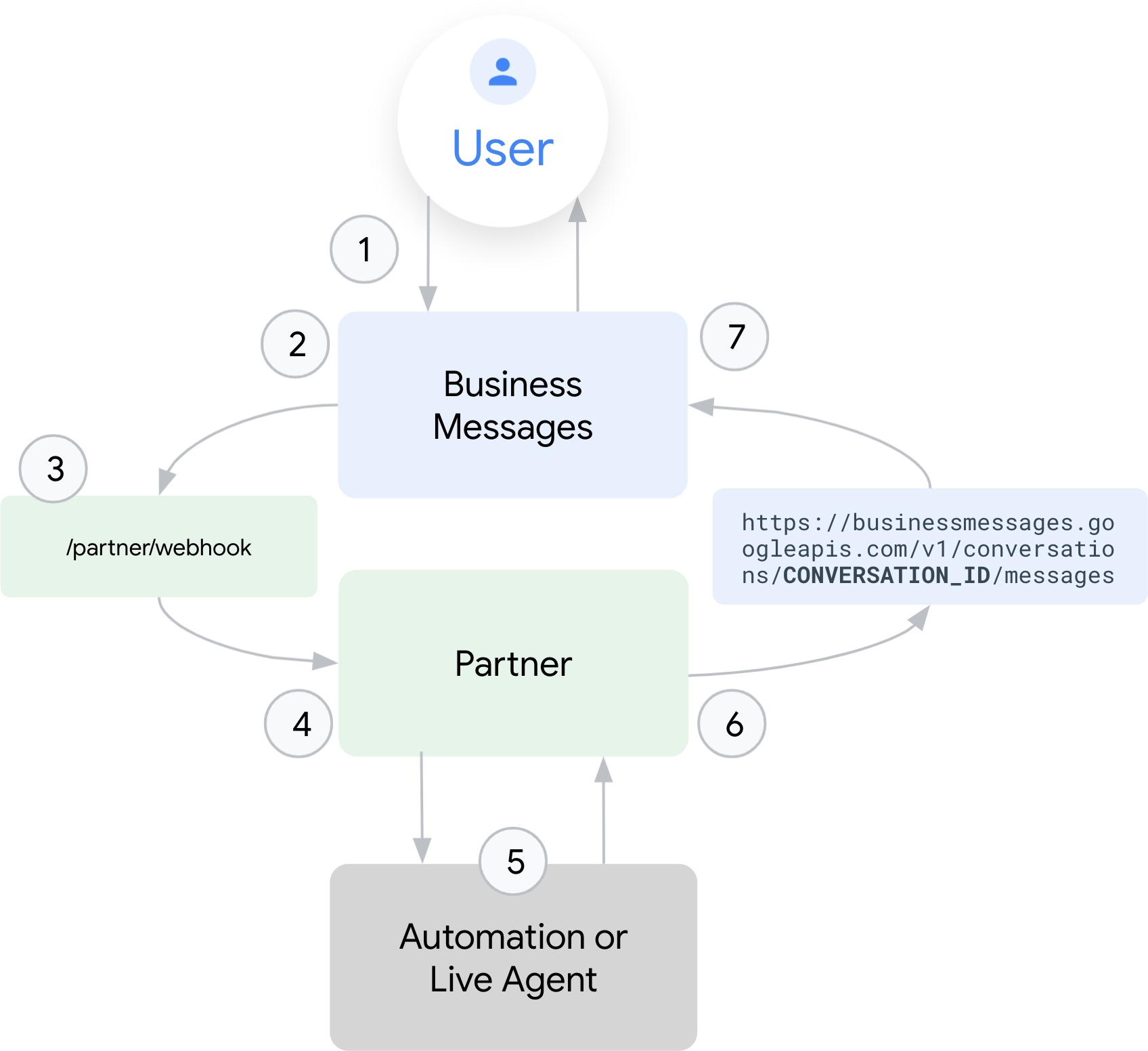사용자가 에이전트에 메시지를 보낼 수 있고, 에이전트가 사용자에게 메시지를 전송할 수 있지만, 전송에는 그 이상의 의미가 있습니다. 메시지마다 다음과 같은 많은 당사자가 관련될 수 있습니다.
- 사용자는 Google 검색, 지도, 브랜드 관리 링크 및 웹사이트의 진입점을 통해 에이전트와 대화를 시작합니다. 사용자는 Google 계정에 로그인해야 하지만 사용자 이름만 파트너와 공유됩니다. 사용자 메시지는 TLS로 암호화됩니다.
비즈니스 메시지는 사용자와 파트너 사이의 레이어 역할을 하며 사용자 개인 정보를 보호합니다. 이 레이어는 각 인바운드 및 아웃바운드 메시지를 복호화 및 다시 암호화하고 사용자의 Google 계정을 대화 ID에 매핑함으로써 사용자의 Google 계정 정보가 파트너 또는 실시간 에이전트와 공유되지 않도록 합니다.
Google은 암호화된 메시지를 저장하여 사용자 기기 간의 전송 및 동기화를 보장합니다. 이러한 저장된 메시지는 제3자와 공유할 수 없습니다. 사용자의 Google ID로만 액세스할 수 있습니다.
에이전트는 파트너가 만들고 관리하는 브랜드를 나타냅니다.
파트너는 브랜드를 대신하여 에이전트를 관리합니다. 파트너는 지정된 웹훅에서 인바운드 메시지를 수신하고 자동화 또는 실시간 에이전트로 인바운드 메시지를 라우팅하여 응답을 작성하고 Business Messages API로 아웃바운드 메시지를 전송합니다.
자동화는 인간 참여 없이 사용자 메시지를 처리합니다.
실시간 에이전트는 인간 참여가 필요한 사용자 메시지를 처리합니다.
각 당사자는 대화 내에서 메시지를 주고받는 데 참여합니다. 엔드 투 엔드 메시지 흐름은 사용자에게 에이전트로 메시지를 보내는 것에서부터 시작하여 에이전트로부터 응답을 수신하는 사용자로 끝납니다.

- 사용자가 대화를 시작하고 Business Messages 상담사에게 메시지를 보냅니다.
- Business Messages는 대화에 ID를 할당합니다. 대화 ID는 영구적이며 사용자와 에이전트에 고유합니다. 같은 사용자가 다른 상담사에게 연락했다면 대화에서 다른 대화 ID를 사용하게 됩니다.
- Business Messages는 암호화된 메시지를 파트너의 웹훅으로 전송합니다. 메시지에는 대화가 시작된 위치의 고유 대화 ID, 에이전트 ID, 메시지 ID, 컨텍스트 정보가 포함됩니다.
- 파트너는 메시지를 수신하여 메시지를 자동화나 실시간 에이전트로 라우팅합니다.
- 자동화를 통해 사용자 메시지에 대한 응답이 자동으로 생성되거나 대화에 액세스할 수 있는 실시간 에이전트가 사용자 메시지를 확인하고 그에 따라 응답을 만듭니다.
- 파트너는 Business Messages API에 대화 ID를 수신자로 하여 응답을 전송합니다.
- Business Messages는 메시지를 복호화하여 다시 암호화하고, 대화 ID를 사용자의 Google 계정과 매핑하며, 사용자에게 메시지를 보냅니다.
